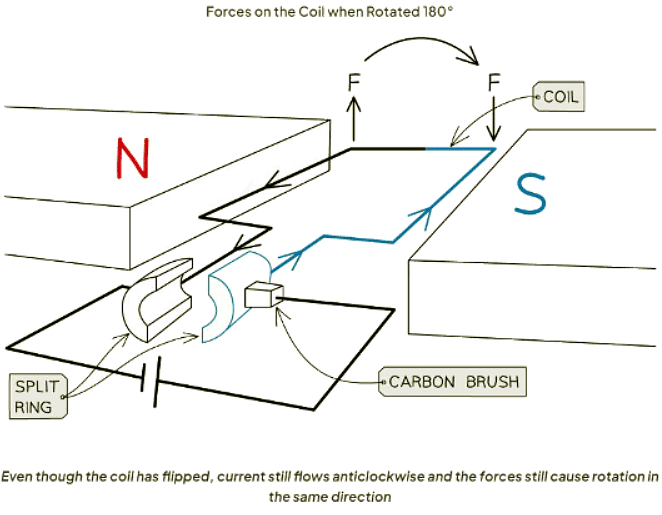Year 11 Exam > Year 11 Notes > Physics for GCSE/IGCSE > Electric Motors
Electric Motors | Physics for GCSE/IGCSE - Year 11 PDF Download
The DC Motor
- The motor effect enables the construction of a basic direct current (d.c.) electric motor.
- Utilizing the force acting on a current-carrying coil, it is propelled to rotate unidirectionally.
- The straightforward d.c. motor comprises a wire coil, which is movable, placed within a consistent magnetic field.

- As the coil carries current, it generates its magnetic field that interacts with the external magnetic field.
- Opposing forces exert on each side of the coil, inducing a rotational effect.
- Enhancing the coil's turning effect accelerates its rotation.
- This turning effect amplifies by augmenting:
- The coil's number of turns,
- The current flowing through the coil,
- The magnetic field's strength.
Operation of a Direct Current (DC) Motor
- In a direct current (d.c.) motor, when the wire coil lies horizontally, it establishes a closed circuit with a cell.
- The coil links to a split ring, which is essentially a metal tube divided into two parts.
- These split rings connect to the cell through conducting carbon brushes, establishing a circuit.

- When current courses through the coil, it generates a magnetic field.
- This magnetic field engages with the uniform external field, resulting in a force applied to the wire.
- Opposing forces operate on each side of the coil, inducing its rotation:
- On the blue segment, where the current moves towards the cell, the force acts upward (following Fleming's left-hand rule).
- Conversely, on the black section, where the current flows away from the cell, the force acts downward.
- Upon the coil rotating 90°, the split ring loses contact with the brushes.
- As a result, no current flows through the coil, leading to the absence of any forces.

- Even in the absence of a force, the coil's momentum enables it to sustain slight rotation.
- Upon reconnection of the split ring with the carbon brushes, current resumes flowing through the coil.
- With the blue side now positioned on the right and the black side on the left due to the coil flipping, the current direction remains unchanged.
- On the left, where the current flows towards the cell, the black side of the coil encounters an upward force, while on the right, where the current moves away from the cell, the blue side experiences a downward force.
- This consistent force distribution enables the coil to persistently rotate in the same direction, thereby establishing a motor that spins continuously.

Question for Electric MotorsTry yourself: What is the function of the split ring in a direct current (d.c.) motor?View Solution
Factors Affecting the D.C Motor
- The rotational speed of the coil can be enhanced by:
- Boosting the current.
- Employing a more potent magnet.
- To change the coil's rotation direction in the d.c. motor:
- Reverse the current flow.
- Invert the magnet's poles to reverse the magnetic field direction.
- To amplify the force supplied by the motor:
- Increase the current within the coil.
- Enhance the magnetic field's strength.
- Add additional turns to the coil.
The document Electric Motors | Physics for GCSE/IGCSE - Year 11 is a part of the Year 11 Course Physics for GCSE/IGCSE.
All you need of Year 11 at this link: Year 11
|
127 videos|148 docs|35 tests
|
FAQs on Electric Motors - Physics for GCSE/IGCSE - Year 11
| 1. How does a DC motor operate? |  |
Ans. A DC motor operates by using the principle of electromagnetism. When a current is passed through the coil of wire in the motor, a magnetic field is created. This magnetic field interacts with the permanent magnets in the motor, causing the coil to rotate and thus creating mechanical motion.
| 2. What is the role of a split ring commutator in a DC motor? |  |
Ans. The split ring commutator in a DC motor is responsible for reversing the direction of the current in the coil of wire as it rotates. This reversal of current ensures that the coil continues to experience a force that causes it to rotate in the same direction, thus maintaining the motor's operation.
| 3. How can the rotation speed of a DC motor be increased? |  |
Ans. The rotation speed of a DC motor can be increased by either increasing the current flowing through the coil of wire or by increasing the number of turns in the coil. Both of these factors contribute to a stronger magnetic field and therefore a higher rotational speed.
| 4. How can the direction of force and rotation be determined in a DC motor? |  |
Ans. The direction of force in a DC motor can be determined by using the right-hand rule, where the thumb points in the direction of the current flow, and the fingers point in the direction of the magnetic field. The direction of rotation can be determined by the direction of the force acting on the coil.
| 5. What is the working principle of an electric motor? |  |
Ans. The working principle of an electric motor is based on the interaction between magnetic fields and current-carrying conductors. When a current is passed through a coil of wire in the presence of a magnetic field, a force is exerted on the wire, causing it to move and thus creating mechanical motion.

|
Explore Courses for Year 11 exam
|

|
Signup for Free!
Signup to see your scores go up within 7 days! Learn & Practice with 1000+ FREE Notes, Videos & Tests.
Related Searches
















